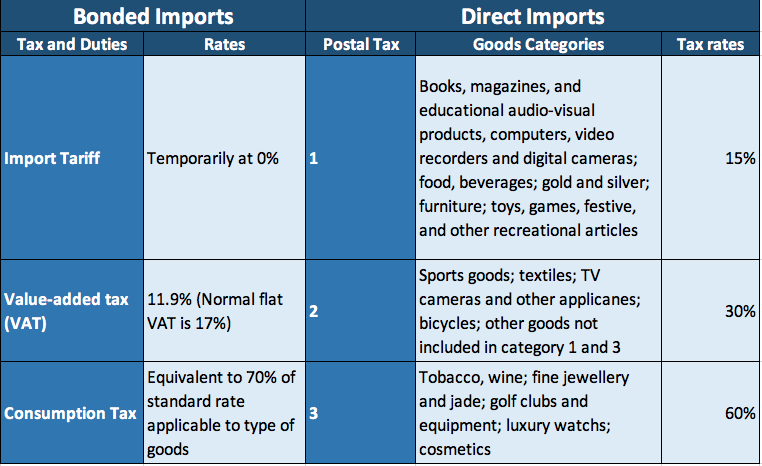2 Essential Component For Cross-border E-commerce in China
With China being one of the largest e-commerce markets worldwide, China have presented many international and national businesses with opportunities for online sales within the population of 1.3 billion people. However, to undergo cross border e-commerce in China for international businesses and companies, there are limitations and restrictions that have been created and revised over the past several years by the government who have overseen the development of the market.

Regulations and Policies
To understand the policies for cross border e-commerce in details, the cross-border e-commerce market is divided into two sectors: B2B and B2C. Additionally, there are different policies that apply to each business model separately.
With the consumer goods, there are regulating policies for all categories of products sold, such as no fresh products for FMCG. And the B2C business model are most frequently used for foodstuffs, dietary supplements, household appliances and cosmetics for cross border e-commerce. All goods from abroad must be sold on a custom supervised e-commerce platform in China to be delivered to consumers.

To outline the process of transactions and shipping, the first step before completing the transaction is the ensure the goods available for sale must be registered with customs authorities prior to their import. Additionally, there is a necessity for a company or business in China to be held responsible and liable for the business transaction, which can be a subsidiary of the seller or business partner.
Importing Models
In the importing process there are two models that businesses can resort to: Direct and Bonded.
Direct purchase imports follow the procedure of directly shipped from oversea businesses and merchants to China using the courier system as a private and personal package.
On the other hand, bonded imports include two separate model to transact and ship, which are Bonded warehouse model and direct mailing model. Bonded warehouse model can be B2B2C (business to business to consumer) is followed by the concept of stock first and order later. Thus, products are imported in bulk to an approved CBEC bonded warehouse zone in China, which then is later shipped from bonded area to consumers after placing an order through e-commerce site or platform through custom clearance.

The direct mailing B2C model follows the concept of order first and deliver later where customers first place an order on the platform. Then, all information is submitted by the platform to customs, where the product is shipped from an oversea distribution centred linked to Chinese customs to deliver to consumers.
All cross-border e-commerce goods for B2C are subjected to postal tax, which is similar to custom duty but intended for private package shipments. The postal tax rates do range from 10% to 50% of the value of the goods, however, if the total value of all orders by one purchaser is under 20,000 RMB and less than 2,000 RMB an individual order, there will be no custom duty required. If the values surpass the numbers mentioned, the rates of postal taxes will be charged exactly to B2B.
The custom duty for B2B varies based on the categories of products and importing model used.
*Postal taxes will not apply to orders under 2,000 RMB and total value of 20,000 RMB within one year from one purchaser
Intellectual Property Protection
In order for businesses and companies to attract audiences and promote sales, there is an important need for innovativeness and creativity. Often times, the creatives or intellectual property can be easily abused by other businesses, making it one of the concerning problems in China. Intellectual property rights violations still remain to be a challenge for businesses whom registered their IPR in the early entrances to the Chinese market.

Trademark Registration
Trademarks are the important representing factors of any businesses and companies. If businesses and companies fail to file the trademark early, businesses may run into the risks of trademark squatters, whom rush-register brands in China under their own names to sell registrations to highest bidders. Another loophole in the government system of China is that China abides by “first to file” principle, where any applicants are first to file the trademark will not be evaluated if applicant is the real business owner.
Oversea businesses and companies are only eligible to register through a trademark agent to register with Trademark Office of The State Administration for Industry & Commerce of the People’s Republic of China. Businesses and companies should have all necessary information prepared for the agent, as the agent will also scan for trademark squatters with matching information. It is also beneficial to keep in mind while registering that companies should prepare the brand name, company name in Chinese, as it is as influential to Chinese consumers, and to clearly classify the category of the business.
With the completion of IP registration, owners are then eligible to take legal measures against any infringer with sufficient evidence of history, earlier registration elsewhere or more to protect themselves.
Patent & Industrial Design Registration
Aside from trademark, product uniqueness is the most important aspects of any brands as it can become the signature product of a brand and companies. For foreign companies, early registrations of patent and/or designs can avoid more infringers from abusing the designs and concepts to create counterfeits. Businesses and companies can register with the State Intellectual Property Office of China with varying fees, where fee calculators are available on the internet to attain an estimated fee for registration.
Prevention Is Key
Brands and companies are highly recommended to regularly scan thorough e-commerce platforms such as Tmall global, JD worldwide and search engines to find any possible counterfeit products or infringements. Any infringement can be submitted to the platform for remedial measures, as the platforms can be held liable for the infringement otherwise. Another option is that brands can directly contact the opposing party for mediation as well.

Brands can also utilize the following tips to prevent and avoid IPR violations, such as adding IPR clauses in agreements with agents, supplies, and distributors to enhance legal liability for infringement. Also registering IPR at Chinese customs can allow authorities to check imports and exports for infringements.
The above aspects mentioned above in regards to regulations and IP are important steps to consider and prepare for in the project to entering the Chinese market through cross border e-commerce ensuring the process more accurately planned and approximated.

 A Complete Guide to Cross-border E-commerce in China
A Complete Guide to Cross-border E-commerce in China


